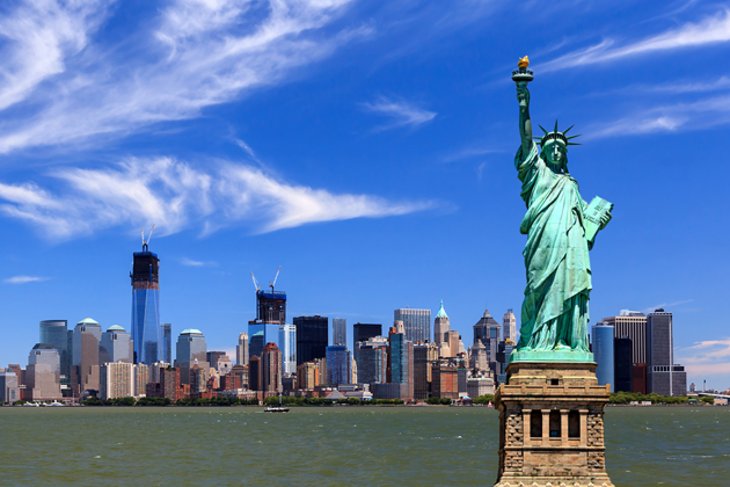New York City Unveiled: A Journey Through its Landmarks, Culture, and Neighborhoods

New York City, often hailed as the epicenter of the modern world, stands as a testament to human ingenuity and cultural diversity. This bustling metropolis, home to over eight million people, is a vibrant tapestry of history, art, and architecture, all coexisting within its sprawling boroughs. Renowned for its iconic skyline, the city is a hub of economic power and a melting pot of cultures, drawing millions of visitors and immigrants from every corner of the globe. Its streets echo with the languages of the world, its neighborhoods each telling their own unique stories. From the historic corridors of Ellis Island to the neon-lit avenues of Times Square, New York City offers a kaleidoscope of experiences that are both deeply American and universally human.
In this context, this paper seeks to analyze the most iconic and culturally significant places in New York City. The focus will be on exploring these landmarks not just as tourist destinations but as pivotal points in the city’s narrative. Each selected location reveals a layer of New York’s multifaceted identity, offering insights into its historical, cultural, and social significance. By delving into the heart of what makes these places resonate with so many, this analysis aims to shed light on how they contribute to the city’s enduring allure and dynamic character. This paper is an ode to New York City’s ability to continually reinvent itself while staying true to its roots, a quality that cements its place as one of the most extraordinary cities in the world.
Criteria for Selection
The selection of places for this analysis is grounded in a multifaceted set of criteria, each reflecting a unique aspect of New York City’s essence:
-
Historical Significance: Places with a rich historical background that have played a pivotal role in shaping the city’s and, in some cases, the nation’s history.
-
Cultural Impact: Locations that are central to the cultural life of the city, including its arts, music, theater, and diverse community practices.
-
Popularity Among Tourists and Locals: Sites that attract both tourists and New Yorkers alike, indicating their relevance and appeal across different groups.
-
Architectural Beauty: Structures and spaces renowned for their architectural innovation, design, and contribution to the city’s skyline.
-
Social and Urban Influence: Spaces that have a significant impact on the social and urban fabric of the city, including public parks, squares, and neighborhoods.
These criteria ensure a comprehensive understanding of the varied dimensions that make each selected place a quintessential part of New York City’s identity.
Research Methods
To undertake this analysis, a diverse array of research methods was employed:
-
Review of Travel Guides and Literature: Consulting various travel guides, both traditional and online, provided insights into the most recommended and visited places in New York City. Additionally, literary works set in New York were perused to understand the city’s portrayal in fiction and non-fiction.
-
Analysis of Visitor Reviews: Online platforms like TripAdvisor, Yelp, and social media sites were scoured for visitor reviews and ratings. These firsthand accounts provided a contemporary perspective on the relevance and experience of the selected places.
-
Consultation of Historical Records: To delve into the historical background of these places, historical records, archives, and scholarly articles were examined. This helped in understanding the evolution of these locations over time.
-
Visual and Documentary Research: Photographic archives, documentaries, and visual media were utilized to gain a visual understanding of the places, particularly their architecture and spatial dynamics.
-
Interviews and Personal Narratives: Where possible, interviews with local historians, tour guides, and residents provided personal narratives and insights that enriched the understanding of these places.
This multi-dimensional research approach ensures a well-rounded analysis, combining historical depth with contemporary relevance and personal perspectives.
Historical Landmarks
New York City’s historical landmarks are not just architectural marvels but symbols of the city’s journey through time. The Statue of Liberty, a colossal neoclassical sculpture on Liberty Island, is more than just a tourist attraction; it’s a symbol of freedom and democracy, greeting millions of immigrants as they entered America. Similarly, the Empire State Building, once the tallest building in the world, represents the city’s architectural ambitions and the American spirit of the early 20th century. Analyzing these landmarks reveals their impact on New York’s identity, standing as testaments to the city’s resilience, growth, and its pivotal role in American history.
Cultural Hotspots
The cultural vibrancy of New York City is perhaps best exemplified in places like Broadway and the Metropolitan Museum of Art. Broadway, the heart of American theater, has been a launching pad for some of the most significant plays and musicals, influencing both American culture and the global entertainment industry. The Metropolitan Museum of Art, one of the largest and most comprehensive art museums in the world, houses a vast collection that spans 5,000 years of world culture. These institutions not only contribute to the city’s cultural landscape but also act as custodians of human creativity and expression.
Social and Urban Spaces
New York City’s social and urban fabric is woven through spaces like Central Park and Times Square. Central Park, an urban oasis, exemplifies the city’s architectural foresight in creating green spaces amidst urban sprawl. It serves as a communal space for recreation, socialization, and cultural events. Times Square, famously known as “The Crossroads of the World,” is a hub of entertainment and commerce, showcasing the city’s dynamic and ever-evolving urban culture. These spaces are integral to New York’s social life, offering a place for both escape and engagement within the city’s fast-paced environment.
Diverse Neighborhoods
The diversity of New York City is perhaps nowhere more evident than in its neighborhoods. Chinatown, with its rich history of immigration, is a vibrant center of Chinese culture and cuisine. Little Italy, though diminished in size, still holds the charm of Italian heritage, resonating in its cafes and festivals. Harlem, historically significant for its role in the African-American cultural renaissance, continues to be a center for music, arts, and African-American culture. Each neighborhood contributes a unique thread to the city’s multicultural tapestry, showcasing how diversity shapes and enriches urban life.
In examining these aspects of New York City, one can see a microcosm of American history and culture, reflecting the city’s role as a crucible of diversity and a beacon of innovation.
Summary of Findings
This analysis of New York City’s most iconic places reveals a multifaceted metropolis that is as historically rich as it is culturally vibrant. The city’s historical landmarks, such as the Statue of Liberty and the Empire State Building, not only define its skyline but also embody the American spirit of freedom, resilience, and ambition. These structures serve as physical reminders of the city’s journey through pivotal moments in history, symbolizing both the dreams and challenges of generations.
The cultural hotspots of New York, exemplified by Broadway and the Metropolitan Museum of Art, highlight the city’s status as a global center for arts and entertainment. These institutions are not just venues for artistic expression; they are also custodians of cultural heritage, influencing trends and tastes far beyond the city’s borders.
New York’s social and urban spaces, particularly Central Park and Times Square, play a crucial role in the city’s urban ecosystem. They act as communal hubs, fostering social interaction and offering respite from the urban hustle. Their design and usage reflect the city’s commitment to creating spaces that cater to both leisure and communal gathering.
Furthermore, the diverse neighborhoods of Chinatown, Little Italy, and Harlem underscore the city’s multicultural identity. Each area offers a unique cultural experience, contributing to the rich tapestry of New York City’s social fabric. Their distinct histories, cuisines, and cultural practices not only enrich the city’s character but also exemplify the American melting pot.
In conclusion, the analysis of these places offers a deeper understanding of New York City’s complex identity. Each landmark, cultural institution, urban space, and neighborhood contributes to the narrative of a city that is constantly evolving yet remains rooted in its rich history and cultural diversity. New York City, through its architecture, arts, and diverse communities, stands as a symbol of human creativity, resilience, and the unending pursuit of progress.





